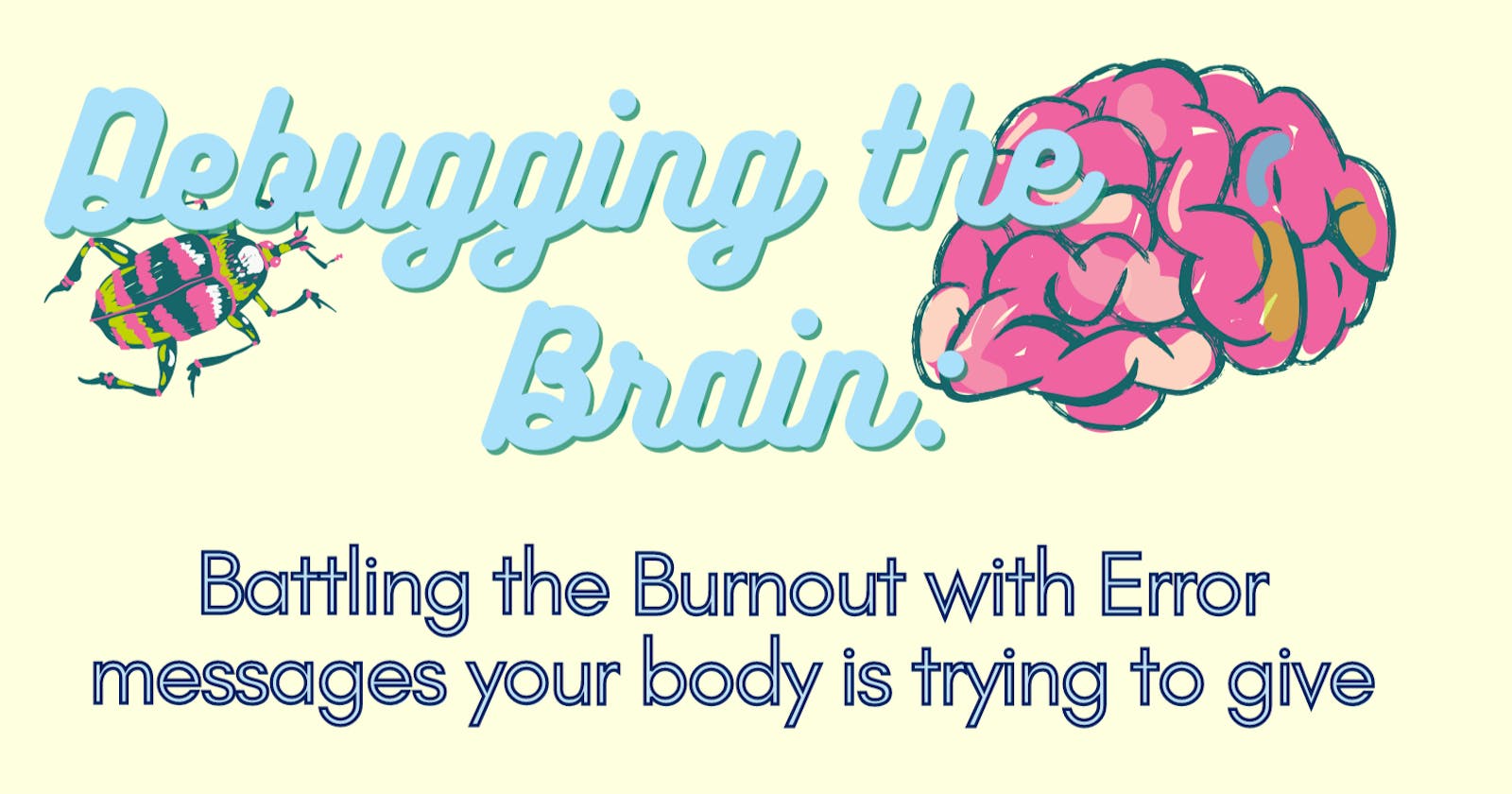Debugging the Brain🧠: Battling the Burnout with Error Messages🛑 your body is trying to give
Even when your mind feels slow and sluggish, remember: your body is a 24/7 active machine, and inside your skull, hard at work, is a supercomputer.

Bugs are an inseparable part of every developer's life, and while developers eventually gain expertise in tracking and resolving them, many of them fail to find or tackle even the smallest bugs in the most brilliantly devised supercomputers that their brains are, which in due course result in burnout.
And while we think these bugs don't show up with error messages, there are certain symptoms often misinterpreted or ignored which can help you identify burnout in an early stage.
Is it burnout or am I just...super lazy?
According to the definition set by World Health Organisation, individuals suffering from burnout are said to experience feelings of exhaustion, increased mental distance, demotivation and cynicism in relation to one’s job, and reduced professional efficacy.
Sometimes, job is not the only stressor in certain cases. From the perspective of a student, and perhaps in my case exclusively, travelling everyday and attending consecutive classes of 6 hours for straight up weeks, constant piling up of assignments and tasks, self study, internship, peer pressure, family commitments, competency and capacity of my body, and many other factors can cause an unbreakable cycle of stress if not handled properly.
Personal experience: Sometimes, my body would become extremely exhausted at the end of a term to a point that I'm unable to get up from my bed for days, even though my brain is wanting me to! So much so, burnout would become indistinguishable from laziness, and I'd begin to question my own dedication and will.
NOTE: The same can be said for misinterpreting depression for burnout. Certain depression-related symptoms, such as exhaustion and difficulty performing tasks, can masquerade as burnout. In most cases, burnout is work-related and doesn’t affect your day-to-day life. Depression, on the other hand, impacts every aspect of your life with persistent feelings of hopelessness, worthlessness or helplessness. Consider contacting a medical professional for better clarification and remedies.
Some of the major symptoms of an early stage burnout that I have experienced (and made the mistake of ignoring):
Holding idealistic expectations of myself and setting unrealistic deadlines for my goals, following the "hustle culture" blindly, without understanding or prioritising the needs of my body and mind.
Overestimating and overcommitting to work but then needing to procrastinate for a long time if stumbled upon a problem that can't be solved immediately.
Inability to balance social, personal and professional life, proceeding to allow the later to become a substitute for both the former ones.
Suffering from fatigue, reduced appetite, insomnia or abnormal sleeping and eating patterns.
Personal experience: When I was first introduced to open-source ecosystem through people who I considered role models (and still do) in this field, like any newbie, I was driven (note: not motivated but driven) by all the glitters (perks) that came with working in open-source organisations, without even considering the experience and effort that it takes to build such recognition through proof of work and commitment. I think, irrespective of the personality trait, everybody at one point is solely driven by the need to gain recognition and rewards within a short span of time (anybody who tells you otherwise is sus 👀) and so did I. When I began to make open source contributions, I often engaged myself in learning new technologies, building projects and maintaining my productivity in the form of green squares in the GitHub contribution graph. This is usually called the honeymoon phase. The problem with me was I tried to do all at once without preparing or following any particular schedule and started pondering why it wasn't working when things started falling out of place. To make tasks fit into the scene, I began cutting off friends, close friends and even family members and diverted that time to study and work. I even forgot to pursue my interest and make any progress in Literature and Poetry. I also gave up the only time that I had dedicated towards nature gazing and exercising (biggest mistake!).
Soon, this honeymoon phase dwindled and I started to face stress from not being able to manage all the tasks properly. Sometimes I would spend days without having the energy to get any task done. This is usually the onset of stress phase and luckily, this was when I could detect the burnout upon googling.
If remained undetected, this can lead to the next phases such as:
chronic stress phase
burnout phase
habitual burnout phase
You can learn more about these phases here.


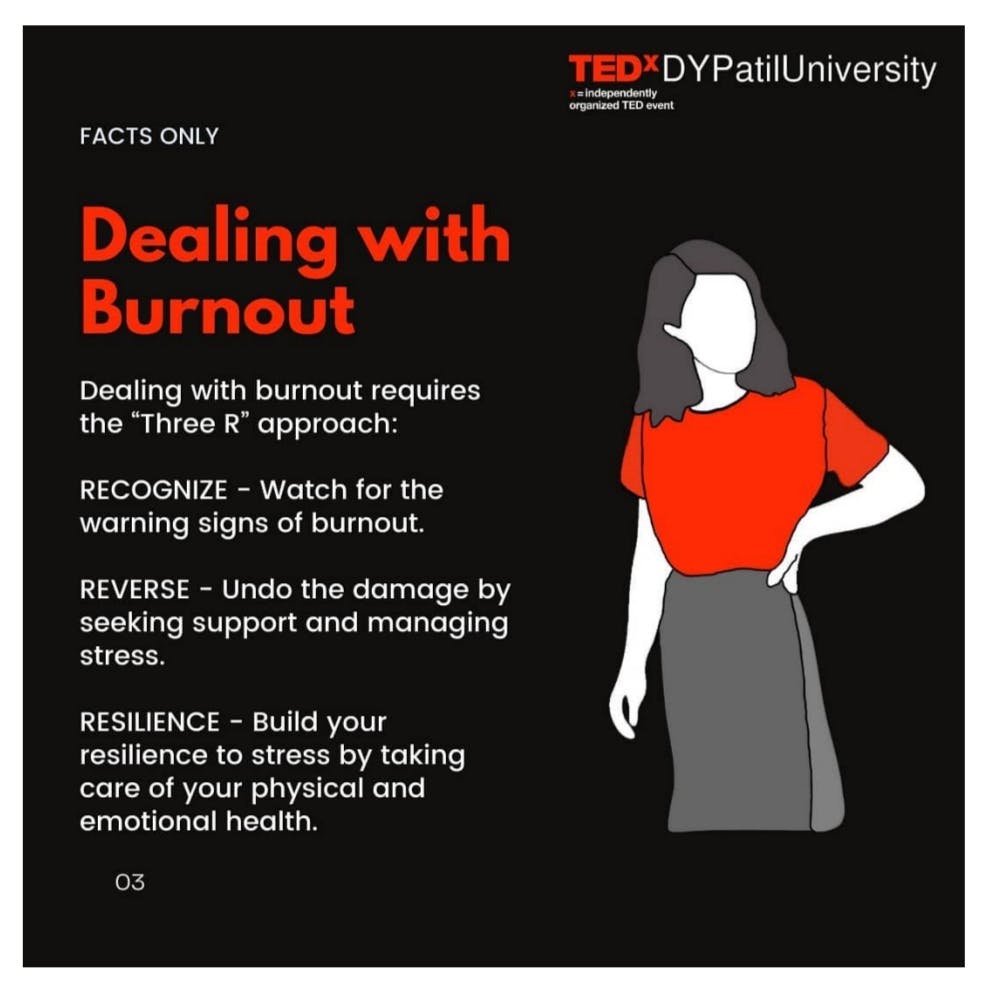
(Image credits: Vaishnavi Dwivedi on LinkedIn)
I like to procrastinate till it's too late. How does it affect anyway?
Now that we have identified some major causes and phases of burnout, we are ready to understand some of the effects that burnout unfolds in our way of life.
Decrement in productivity
Even though burnout begins with a sudden surge of drive and ambition, it ultimately drains you out of energy and interest towards doing any job related task and induces the tendency to procrastinate continuously. Procrastination in turn leads to lowered productivity.
Impostor syndrome
When burnout occurs, it instills a sense of self-doubt and impostor syndrome due to reduced productivity. This results in diminished pride in one's own work, lack of focus, obscurity in goals, etc.
Triggered anxiety
Continuous stress from burnout also leads to trigger of anxiety (increased heart rate, panic, fear, etc.), which might give rise to an endless cycle of social isolation, clinical depression and eating/sleeping disorders impairing your ability to complete even routine activities, let alone job related tasks.
How do I get my brain to work around the burnout?
🌟 Motivation
It is difficult to pull yourself out of the burnout cycle without a little motivation.
Looking back at your good deeds and achievements
Dissociation of your identity and worth from your job is a very important step to take. You are not the GitHub contribution graph or long Duolingo streaks, you are what is inside your heart and mind. It is important to look back at all that you have achieved in the past: whether those are baby steps towards becoming a good developer or a good human or both, or whether you have made your parents happy with your kindness or your friends smile with your quick wit and humour.
Resuming your hobby
Exploring one's creative and fun side helps a lot in reducing stress and releasing adequate amount of the happy-hormones. During my burnout period, I resumed reading books, writing poems and gained quite some interest in cooking.
🌟 Following the rule
As someone who has gone through this before, I recommend following the "Recognize Reverse Resilience" rule to break the chain. Let's learn this in terms of debugging a code.
• Recognize (Locating the bug and understanding its cause)
A stitch in time saves nine.
This is similar to reproducing the bug to understand its source and cause. It's difficult to do so if a bug or anomaly, by having ripple effects, produces more bugs whose effects maybe subtle to more serious and damaging effects.
Like in any medical condition or illness, recognizing and identifying the signs of burnout during its early stage onset is important, as there will be less damage to recover from.
• Reverse (Determining a fix for the bug)
This is similar to the process of determining a permanent solution to fix the bug and reversing the damage that has been caused.
The most vital aspect of reversing the damage caused by burnout is to REACH OUT. It is better to seek help than to suffer silently. Just like looking at the code from a fresh perspective in order to track errors sometimes calls for support from a fellow programmer, it is equally important to reach out for support from family, friends or mentors and talk to them openly about your short-term and long-term goals, your mental and physical capacity and situation, your symptoms and other important information in order to design a strategy to break the cycle of burnout.
• Resilience (Making sure the bug doesn't appear again)
After fixing the bug, it is important to reassure that the existing bug or any other ones do not occur (again). Similarly, resilient measures should be taken to avoid burnout in the future.
Sustenance and persistence are the two sides of resilience. There will be times when you won't have the bandwidth to struggle, and that's okay! Giving your body the nourishment and care it deserves plus fulfilling its needs is as important as utilising it to achieve your personal needs. Sometimes there's striving and achieving, and other times plainly sustaining and pushing oneself through the day. But the struggle to even sustain shouldn't persist for too long, which otherwise might indicate burnout. Take required steps to manage your stress and keep burnout at bay!
How do I keep the burnout at bay?
📌 Setting clear, realistic and achievable goals and dividing them into smaller tasks
Eradicate burnout from the root by not letting high ambitions control the way you frame your goals. Split the long-term goals into several short-term goals or further into small manageable tasks and establish specific objectives or sub-tasks for these smaller goals that can be achieved within a limited amount of time, such as completing a project, wrapping up your assignments for the day, write an application for a particular position, or maybe resolve an issue and create a pull request.
Bonus: Upon completion of each task with a green check ✅, I used to reward myself with timed treats such as a dessert or a short walk in the garden to help me refresh for the next task.
The green checks ✅ acted as a token of reward and satisfaction to me for doing my best to stay productive, and the short breaks helped clear the fog in my brain from the previous task.
What worked for me best was the partial combination of The Ivy Lee Method and Pomodoro Technique to accomplish my tasks. We will be discussing these approaches in the upcoming section.
You are not obliged to follow any particular technique or method, but you can combine these techniques to create one of your own, as long as it suits you and enhances your productivity.
📌 Prioritising your tasks and enhancing your productivity
There are several methods to prioritise your tasks, such as The Eisenhower Matrix, The Ivy Lee Method, Moscow Prioritisation, and time management techniques such as Pomodoro Technique, etc.
Here's a blog that can help you understand prioritisation science in a better way, but for now, we will briefly discuss the only three that worked best for me. However, this may differ from person to person.
• The Eisenhower Matrix: This method basically requires you to divide your to-do list into four quarters: Important-Urgent, Not Important-Urgent, Important-Not Urgent and Not Important-Not Urgent. You can divide your tasks accordingly in the order of priority.
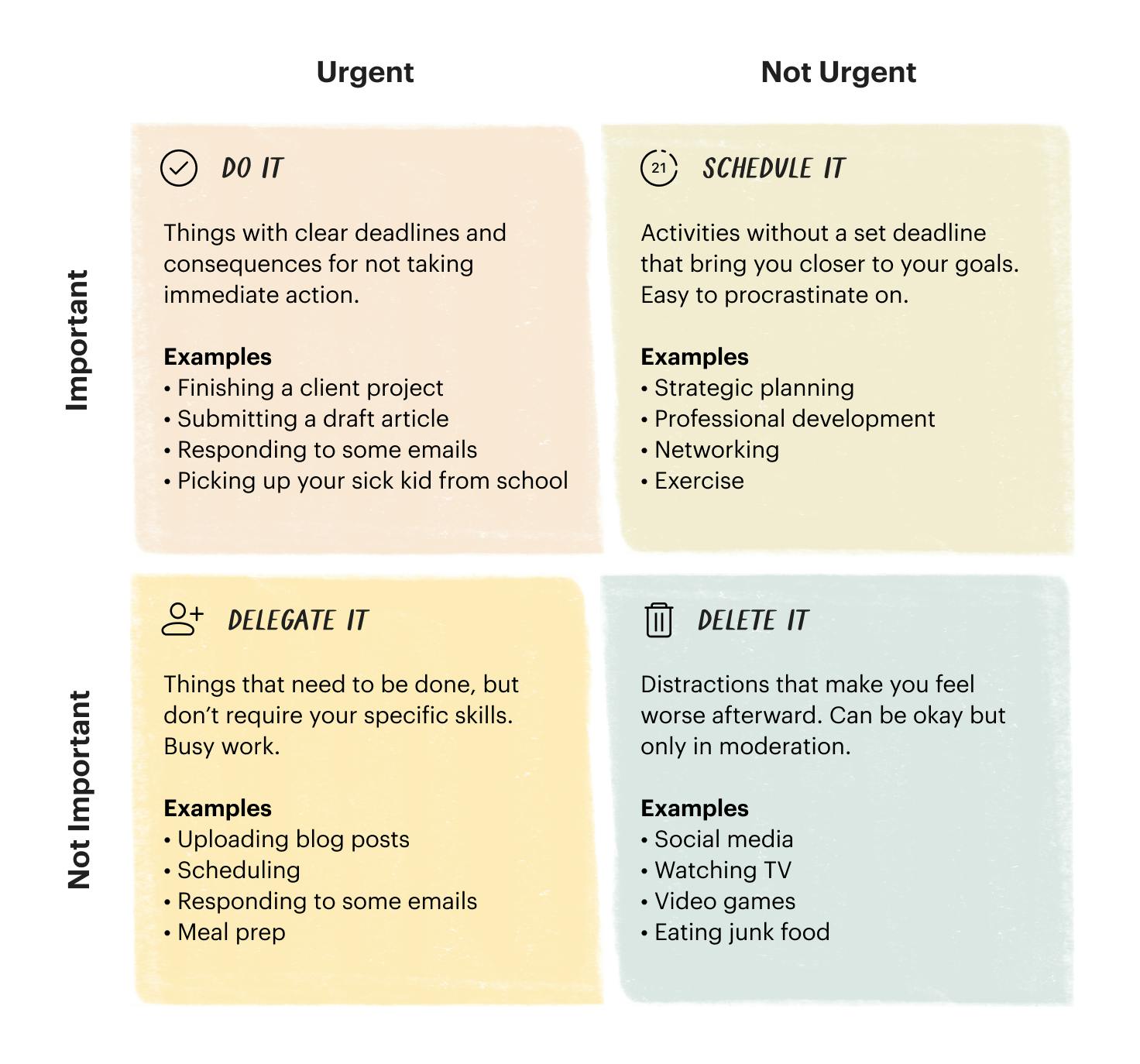
• The Ivy Lee Method: This method includes making a list of six most important tasks to be accomplished by the end of the workday and prioritising them in the order of their actual importance, proceeding to complete them one by one in the same order, followed by moving the leftover tasks (if any left) to the top of the list for the next day because they are to be focused on first the next workday before proceeding to the upcoming tasks for the day. This process is to be repeated to maintain a steady progress.
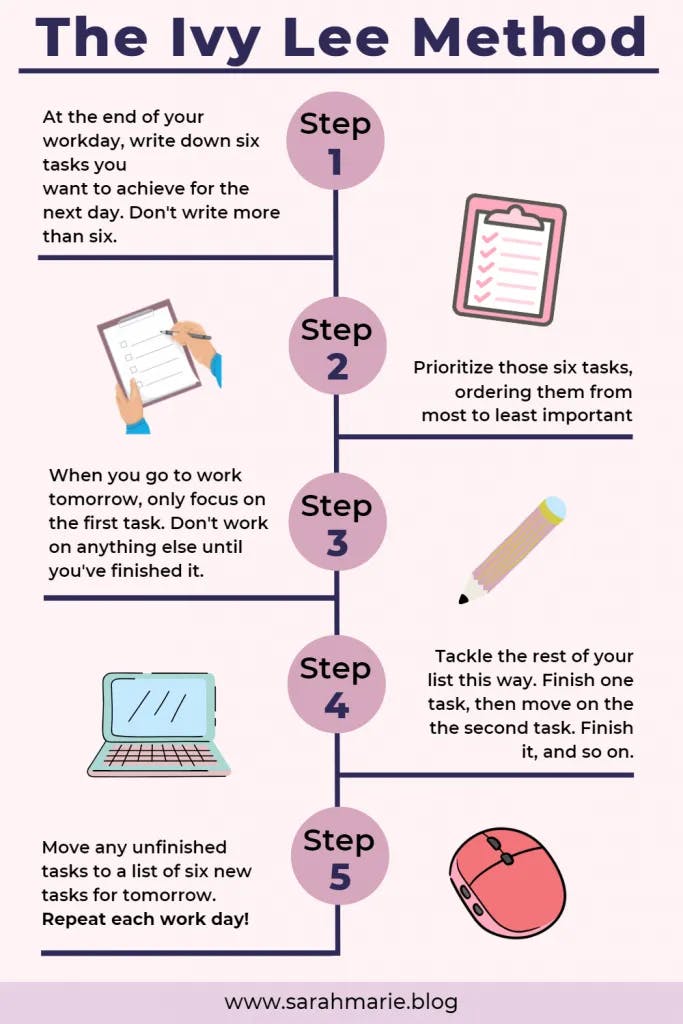
• MoSCoW Prioritisation Technique: This task prioritization method is similar to The Eisenhower Matrix Technique featuring four priority sets: “WOULD have” (would like to accomplish but most likely won't get the time so can be shifted to next day's MUST have list), “COULD have” (desirable but not mandatory), “MUST have” (most crucial) and “SHOULD have” (important and needed to be accomplished right after the crucial tasks). Besides playing an indispensable role in the project management and software development management, this method can also be adopted into personal life where a timeframe is set so that the concentration remains on the critical tasks.
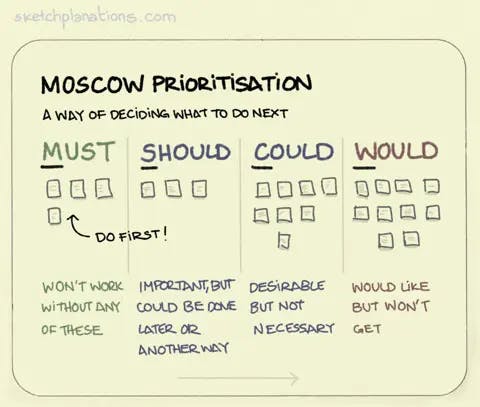
• Pomodoro Technique: This is not a prioritization technique, rather an effective way to execute the prioritization methods efficiently. The Pomodoro Technique is a time management method based on 25-minute stretches of focused work broken by five-minute breaks. Longer breaks, typically 15 to 30 minutes, are taken after four consecutive work intervals. For breaks, it is recommended to not indulge in distractions that can potentially break your concentration, rather advised to involve in non-work related, health focussed tasks that can provide you mental and physical refreshment. This includes, doodling, spending some time with family and pets, listening to therapeutic music or soft songs, taking a short walk outside and interacting with nature, keeping oneself hydrated, etc. I personally wouldn't consider having full fledged heavy meals during the short breaks since large meals especially those rich in protein and carbohydrates typically induce tiredness and are most likely to make me feel sleepy, but this may vary from person to person.

📌 Maintaining a Journal of your learnings
These task management and time boxing techniques condition our minds towards a reward based productivity, in which, completion of tasks surely does happen but most of the time is wasted on listing, prioritization and deletion of tasks, while focus on the retention of knowledge is reduced. To ensure that our main objective of learning is being fulfilled and that we are unafraid to dedicate our time towards tackling any obstruction we face during the completion of a task, maintaining a tangible record of our learnings is recommended. This record or journal helps us revisit and review our learnings from "the tasks we completed" or from "the resolution of the problems we came across during the completion of the said tasks" throughout the day and acts as a proof and measure of our actual productivity. These records can be maintained in the form of a personal journal and kept to yourself or in the form of daily blogs and shared with fellow developers for accountability purpose.
Conclusion
If not all, most of these techniques or practices have remained effective for me through practical implementation and consistency. Each individual's body and brain finds a different way to communicate the symptoms to oneself. It is YOU who needs to identify and correct them, because not all of those errors ❌ and warnings ⚠️ come inside a popup box, nor emphasized in red, blue or yellow.
Thank you for reading my blog. May the force of consistency, productivity and good health be with you!

